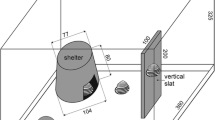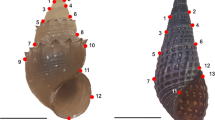Summary
Numerous ecological studies have dealt with the shell color and banding polymorphism of the land snail Cepaea nemoralis. The present field and laboratory investigations focus on the roles of opioid systems in modulating the thermal preferences and behavioral thermoregulation of various morphological types of Cepaea. Evidence is presented that differences in opioid modulation of the thermal responses of Cepaea are associated with shell polymorphism. It is shown that the effects of the prototypic opiate agonist, morphine, and antagonist, naloxone, on behavioral thermoregulation in Cepaea vary with the shell banding pattern and thermal microhabitat. In both the field and laboratory, morphine (0.10, 1.0 and 10 μg per snail) caused significant dose- and time-dependent increases in the temperatures selected by various morphological types of Cepaea. The palest shell type (yellow, unbanded) with the highest basal preferred temperature displayed the greatest response to morphine, the shell type (yellow, 2-banded) with an intermediate basal preferred temperature showed an intermediate response to morphine, and the darkest shell type (yellow, 5-banded) with lowest basal preferred temperature showed the least increase in preferred temperature after administration of morphine. These effects of morphine were blocked and reversed by naloxone (1.0 μg), with the opiate antagonist by itself (1.0 and 10 μg) causing a significant decrease in behaviorally selected temperatures. The unbanded and 2-banded morphs displayed significantly greater decreases in preferred temperatures after treatment with naloxone than did the 5-banded morph, which showed minimal responses. It is suggested that these differences in opioid modulation of thermal preferences and behavioral thermoregulation may contribute to the polymorphic thermal preferences of natural populations of Cepaea.
Similar content being viewed by others
Abbreviations
- B:
-
yellow five-banded shell type
- I:
-
yellow two-banded shell type
- U:
-
yellow unbanded shell type
References
Adler MW, Geller EB, Rosow CE, Cochin J (1988) The opioid system and temperature regulation. Ann Rev Pharmacol Toxicol 28:429–449
Amit Z, Galina H (1986) Stress-induced analgesia: adaptive pain suppression. Physiol Rev 66:1091–1120
Bergstrom PW, Whelan JG (1988) Effects of food and shell morph on temperature preferences of Cepaea nemoralis. Malacologia 29:341–346
Burrowes WR, Assanch P, Stefano B (1983) Behavioral effects of opiates on the land snail Helix aspera. Life Sci 32:381–384
Cain AJ (1983) Ecology and energetics of terrestrial molluscan populations. In: Russell-Hunter WD (ed) The Mollusca, vol 6. Academic Press, New York, pp 597–647
Cameron RAD (1970) The effect of temperature on the activity of three species of helicid snail (Mollusca: Gastropoda). J Zool 162:303–315
Dalton LM, Widdowson I (1989) The involvement of opioid peptides in stress-induced analgesia in the slug Arion ater. Peptides 10:9–13
Frischknecht HR, Siegfried B, Waser PG (1988) Opioids and behavior: genetic aspects. Experientia 44:939–944
Heath EJ (1975) Color, sunlight and internal temperature in the land snail, Cepaea nemoralis. Oecologia 19:29–38
Hirst M, Kavaliers M (1987) Levorphanol but not dextrophan suppresses the foot-lifting responses to an aversive thermal stimulus in the terrestrial snail (Cepaea nemoralis). Neuropharmacology 26:121–123
Innes DGL, Kavaliers M (1987) Opiates and deer mouse behavior: differences between island and mainland populations. Can J Zool 65:2504–2512
Jaremovic R, Rollo CD (1979) Tree climbing by the snail Cepaea nemoralis (L.): a possible method of regulating temperature and hydration. Can J Zool 57:1010–1014
Jones JS (1973) Ecological genetics and natural selection in molluscs. Science 182:546–552
Jones JS (1982) Genetic differences in individual behavior associated with shell polymorphism in the snail, Cepaea. Nature 298:749–750
Jones JS, Leith BH, Rawlings P (1977) Polymorphism in Cepaea: a problem with too many solutions. Annu Rev Ecol Syst 8:109–143
Jones JS, Selander RK, Schnell GL (1980) Patterns of morphological and molecular polymorphism in the land snail Cepaea nemoralis. Biol J Linn Soc 14:359–387
Kavaliers M (1982) Pineal mediation of the thermoregulatory and behavioral activating effects of β-endorphin. Peptides 3:379–385
Kavaliers M (1989) Polymorphism in opioid modulation of the thermal responses of the land snail Cepaea nemoralis. Can J Zool 67:2721–2724
Kavaliers M, Hirst M (1984) The presence of an opioid system mediating behavioral thermoregulation in the terrestrial snail, Cepaea nemoralis. Neuropharmacology 23:1285–1289
Kavaliers M, Hirst M (1986) Evolutionary aspects of opiate involvement in thermoregulation. In: Stefano GB (ed) Handbook of comparative opioid and related neuropeptide mechanisms, vol 1. CRC Press, Boca Raton, Fla., USA, pp 139–152
Kavaliers M, Ossenkopp K-P (1991) Opioid systems and magnetic field effects in the land snail, Cepaea nemoralis. Biol Bull 180:301–309
Kavaliers M, Hirst M, Teskey GC (1983) A functional role for an opiate system in snail thermal behavior. Science 220:99–101
Kavaliers M, Courtenay S, Hirst M (1984) Opiates influence behavioral thermoregulation in the curly-tailed lizard (Leiocephalus carinatus). Physiol Behav 32:221–224
Kavaliers M, Hirst M, Teskey GC (1985a) The effects of opioid and FMRF-amide peptides on thermal behavior in the snail. Neuropharmacology 24:621–626
Kavaliers M, Hirst M, Teskey GC (1985b) Opioid systems and feeding in the slug, Limax maximus: similarities to and implications for mammalian feeding. Brain Res Bull 14:681–685
Kream RM, Zukin RS, Stefano GB (1980) Demonstration of two classes of opiate binding sites in the nervous tissue of the marine mollusc, Mytilus edulis. J Biol Chem 225:9218–9224
Leung MK, Stefano GB (1984) Isolation and identification of enkephalins in pedal ganglia of Mytilus edulis (Mollusca). Proc Nat Acad Sci USA 81:955–958
Leung MK, Stefano GB (1987) Comparative neurobiology of opioids in invertebrates with special atteniton to senescent alterations. Prog Neurobiol (Oxford) 28:131–159
Leung MK, Boer HH, van Minnen J, Lundy J, Stefano GB (1990) Evidence for an enkephalinergic system in the nervous system of the pond snail, Lymnaea stagnalis. Brain Res 531:66–71
Martin WR (1984) Pharmacology of opioids. Pharmacol Rev 35:283–323
O'Neill JB, Pert CB, Ruff MR, Smith CC, Higgins WJ, Zisper B (1988) Identification and characterization of the opiate receptor in the ciliated protozoa, Tetrahymena. Brain Res 450:303–315
Richards AV, Murray J (1975) The relation of phenotype to habitat in an introduced colony of Cepaea nemoralis. Heredity 34:128–133
Richardson AMM (1974) Differential climatic selection in natural population of land snail Cepaea nemoralis. Nature 247:572–573
Richardson AMM (1975) Energy flux in a natural population of the land snail, Cepaea nemoralis L. Oecologia 19:141–164
Santoro C, Hall LM, Zukin MS (1990) Characterization of two classes of opioid binding sites in Drosophila melanogaster head membranes. J Neurochem 54:164–170
Singh SM (1981) Polymorphism in colonies of the land snail Cepaea nemoralis at London, Ontario: changes over three decades. Can Field Nat 95:192–197
Smith LH Jr (1981) Quantified aspects of pallial fluid and its affect on the duration of locomotor activity in the terrestrial gastropod (Triodopsis albolarbis). Physiol Zool 54:407–414
Spencer RL, Hruby VJ, Burks TF (1988) Body temperature response profiles for selective mu, delta and kappa opioid agonists in restrained and unrestrained rats. J Pharmacol Exp Ther 246:92–101
Spencer RL, Hruby VJ, Burks TF (1990) Alteration of thermoregulatory set point with opioid agonists. J Pharmacol Exp Ther 252:696–705
Stefano GB (1982) Comparative aspects of opioid-dopamine interaction. Cell Mol Neurobiol 2:167–178
Stefano GB (1989) Role of opioid neuropeptides in immunoregulation. Prog Neurobiol (Oxford) 33:149–153
Steigen AL (1979) Temperature effects on energy metabolism in banded and unbanded morphs of the snail Cepaea hortensis. Oecologia 41:163–174
Tilling SM (1983) An experimental investigation of the behavior and mortality of artificial and natural morphs of Cepaea nemoralis (L.). Biol J Linn Soc 19:35–50
Wolda H (1965) Some preliminary observations on the distribution of the various morphs within natural populations of the polymorphic land snail Cepaea nemoralis (L.). Arch Neerl Zool 16:280–292
Wong M, Gelperin A, Delaney K (1991) Opiate agonists activate feeding in Limax: comparisons of in vivo and in vitro effects. Behav Neurosci 105:15–24
Author information
Authors and Affiliations
Rights and permissions
About this article
Cite this article
Kavaliers, M. Opioid systems, behavioral thermoregulation and shell polymorphism in the land snail, Cepaea nemoralis . J Comp Physiol B 162, 172–178 (1992). https://doi.org/10.1007/BF00398344
Accepted:
Issue Date:
DOI: https://doi.org/10.1007/BF00398344




